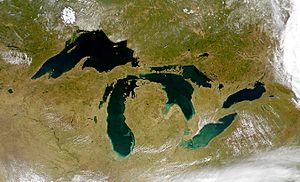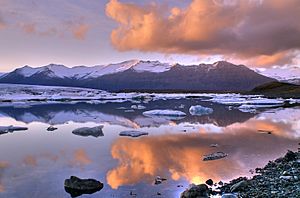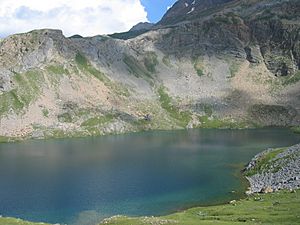Glacial lake facts for kids




A glacial lake is a lake that forms when a glacier melts. Imagine a giant river of ice slowly moving across the land. As it moves, it carves out the ground, creating a big hollow space. When the glacier melts, this space fills up with water, forming a lake.
Contents
How Glacial Lakes Form
Glacial lakes mostly formed near the end of the last Ice Age, about 10,000 years ago. During this time, huge glaciers covered much of the Earth. As the climate warmed, these glaciers began to shrink and move backward, a process called "retreating."
When a glacier retreated, it often left behind large chunks of ice in low areas between drumlins (small oval hills) or other hills. As the Ice Age ended, these ice chunks melted. The meltwater then filled the hollows, creating many lakes. A great example of this is the Lake District in Northwestern England.
Signs of Glaciers
If you see a glacial lake, you might also find other signs that a glacier was once there. These include:
- Drumlins: Small, smooth hills shaped like half an egg.
- Moraines: Piles of rock and dirt left behind by the glacier.
- Eskers: Long, winding ridges of sand and gravel.
- Striations: Scratches on rocks made by the glacier dragging stones.
- Chatter marks: Small, crescent-shaped chips on rock surfaces.
Why Glacial Lakes Look Green
Glaciers are incredibly powerful. As they move, they grind up rocks into a very fine powder, almost like flour. This powder is called "rock flour." When the glacier melts, this rock flour gets into the lake water.
These tiny mineral particles in the water help tiny algae (like microscopic plants) to grow. The large amount of algae can make the lake water look a beautiful green or turquoise color.
Where to Find Glacial Lakes
Glacial lakes are found in many parts of the world where glaciers once existed. You can often spot them in aerial photos of the land in places like:
- Canada
- The U.S.
- Russia
- Argentina
- Iceland
- Spain
- New Zealand
- Tibet
- The United Kingdom
- Norway
- Sweden
- Australia
The coastlines near these areas are often very bumpy and uneven. This is because the same powerful glaciers that formed the lakes also carved out the land along the coasts. Other areas have fewer lakes and smoother coastlines, as they were shaped more by erosion from rivers and weather.
Related Pages
Images for kids
-
The prehistoric glacial lake Agassiz once held more water than all lakes in the world today.
-
One of the Valyavishki Lakes and Gazey Summit, Pirin Mountain, Bulgaria
-
Laminated claystone from Glacial Lake Missoula, Montana, United States
-
Saif-ul-Malook Lake in Kaghan Valley, Pakistan
-
Katora Lake in Kumrat Valley, Pakistan
-
Ratti Gali Lake in Neelum Valley, Pakistan
-
One of the Samodivski Lakes, Pirin Mountain, Bulgaria
-
Lake Kaniere in the West Coast region of New Zealand
See also
 In Spanish: Lago glaciar para niños
In Spanish: Lago glaciar para niños














